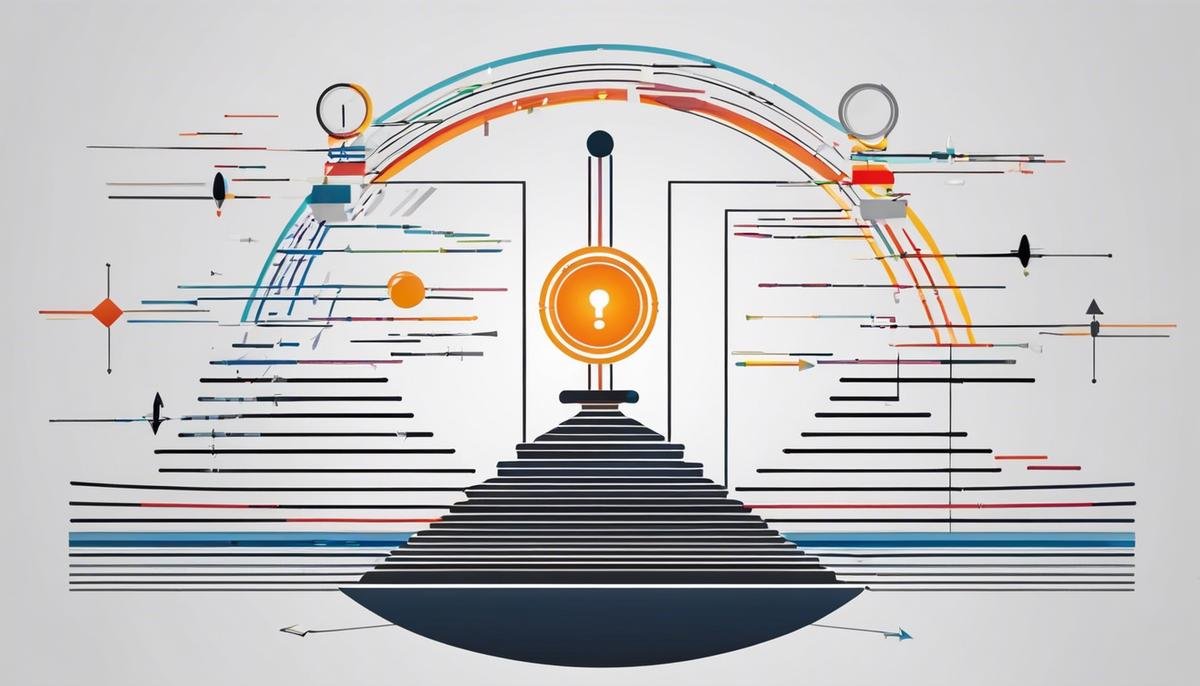As we witness the dawn of a new era, the intertwining worlds of technology and law enforcement face potential revolution with the steady assimilation of Artificial Intelligence (AI). From predictive analytics and facial recognition to drones, AI technologies subtly but steadily transform European policing strategies and practices. Despite the perceived advantages, this transformative shift from traditional methods to unprecedented digital tools prompts far-reaching questions concerning the criminal justice process, from investigations and evidence gathering to prosecution and sentencing. Taking a critical lens, this exploration delves into the ethical strings attached to AI use—bias, transparency, accountability—and the significant implications these carry for societal and individual perspectives, particularly in privacy rights and diligence in the justice system.
AI implementation in Law Enforcement
Evolution of European Law Enforcement: The Remarkable Influence of Artificial Intelligence
The world of technology can be a thrilling adventure, particularly when one appreciates the formidable power it offers to stimulate change. As the dawn of Artificial Intelligence (AI) breaks upon us, no realm, including law enforcement in Europe, is exempt from this transformative wave.
In recent years, Europe has manifested an impressive hustle towards embracing AI in policing, thereby optimizing law enforcement capacities. Policymakers, researchers, and law enforcement agencies are collaboratively paving avenues for AI introduction, understanding the unprecedented potential it possesses to revolutionize crime prediction, prevention, and response mechanisms.
One of the groundbreaking AI applications in Europe’s law enforcement is the prediction of crime hotspots. Previously deemed as an abstraction from a sci-fi motion picture, it now thrives in nations like the United Kingdom. The Kent Police, in 2013, implemented a predictive mapping software called PredPol, which uses AI algorithms to predict potential crime hotspots based on historical crime data, enabling efficient patrolling deployments.
Moreover, AI efficacy extends beyond patterns and spreads itself seamlessly over faces and voices, proving to be a boon for surveillance. European nations are increasingly implementing facial recognition technology to identify criminals. British police forces use an AI system known as NeoFace Watch, which cross-references CCTV footage against databases of mugshots, serving as a transformative tool to catch culprits. Furthermore, voice recognition systems are finding a place in spheres where wiretapping is considered permissible by law to track activities of crime suspects.
Notwithstanding, the integration of AI into border security and immigration control in Europe has been a breakthrough. For instance, iBorderCtrl, an EU-funded pilot project, harnesses AI technology to detect lies from visitors who do not require visas to travel within the EU based on their facial micro-expressions.
Significantly, AI also provides an edge in analyzing vast volumes of online data to track and preempt crimes in the digital domain, like cyber attacks, online scams, and the dark web’s illicit activities. Notably, the AI-powered software “Valcri” aids investigators in digging through massive amounts of data swiftly, providing an augmented reality view of crime scenes, and opening new avenues for detecting hidden connections.
However, these leaps need to be tempered with astute awareness of the potential pitfalls. Concerns about mass surveillance, questionable accuracy, and privacy breaches are paramount. These issues prompt rigorous debates, underscoring the need for robust regulatory standards, stringent oversight mechanisms, and periodic audits to ensure this technology aligns with human rights and privacy norms.
In conclusion, as AI duly takes its place within European law enforcement, it offers extraordinary prospects for enhancing efficiency and speed of justice. Yet, scaling this unchartered territory requires caution, constant vigilance, and a strong commitment to ethical standards and human rights. Indeed, traversing this frontier of modern law enforcement signals not just a technological evolution but also a test of Europe’s democratic resilience.

AI and Criminal Justice
Expanding further into the impact of AI on the European criminal justice system, one must consider the directives in corrections. Artificial Intelligence has the potential to significantly transform the correctional system through applications such as risk prediction tools and digital therapeutics. These risk prediction tools could lead to a future where preventive measures are enhanced to reduce recidivism rates drastically. Data from various psycho-social, familial, educational, and criminal records can be analyzed to determine an individual’s likelihood of reoffense, thereby allowing personalized prevention approaches.
Additionally, the incorporation of digital therapeutics provides exceptional potential for transformative reform in the approach to prison rehabilitation. Tailored rehab programs could employ AI-driven therapeutic platforms that adapt to the learning pace and style of prisoners.
However optimistic these possibilities appear, they are not without potential pitfalls. The integration of AI into the corrections system may reignite ongoing debates about determinism and free will, exacerbating ethical quandaries regarding punishment and rehabilitation. Moreover, the bias, which can be latent within AI algorithms – from data collection to model deployment – poses a high risk of unjustly skewing the justice system against specific demographic groups.
Shifting the lens to judicial proceedings, AI has the potential to expedite the entire process significantly. AI-driven text analysis tools can sift through vast quantities of legal texts, precedents, and regulatory changes, providing judges, attorneys, and paralegals with relevant insights. While this technology vastly enhances the efficiency of case processing, it is incumbent upon the legal profession to interrogate its systems and processes continuously. AI is prone to inherent biases, as they are largely built and trained by humans, which could lead to prejudices that negatively impact fairness in the justice system.
Another area of potential impact lies within the realm of digital forensics. With cybercrimes on the rise, AI can be employed to detect, respond, and pre-empt cyber threats. Its application in this regard goes beyond the simple analysis and tracking of online data, extending to advanced threat intelligence and automated crime prediction models.
At the crossroads of these multifaceted considerations lie the dynamics of power, accountability, and regulation. Given that many AI applications are under proprietary control, a balanced power relation between public and private spheres is essential for distributing control, preventing monopolistic tendencies, and allowing transparency. Moreover, robust accountability measures need to be in place to monitor AI applications and ensure that they align with international human rights and legal standards.
Indeed, the trajectory of AI technology within the European criminal justice system is laden with both promise and challenge. How we harness its potential while ensuring ethical responsibility will significantly affect how AI will impact law enforcement, corrections, judicial proceedings, and digital forensics. The concentrated effect of AI on European criminal justice thus extends beyond a technological revolution; it embodies a reimagination of justice and social order.

Ethical implications of AI in Law Enforcement
Diving deeper into the impact of artificial intelligence (AI) in law enforcement, it becomes clear that AI’s use extends far beyond the stages of crime prediction and surveillance. Fixating the lens on the European criminal justice system uncovers novel potential applications of AI, such as in corrections and digital therapeutics.
Undeniably, AI could revolutionize the corrections environment. In this sector, AI-infused risk prediction tools have been proposed to assist in parole decisions and rehabilitation program assignments, potentially providing more objective assessments. Yet, significant ethical questions underpin this proposition. The potential magnification of existing biases in the system – due to the inherent bias in AI’s training data – could exacerbate social injustice instead of resolve it. Thus, it is vital to question a system that may disproportionately disadvantage those already marginalized in society.
In tangent with this, AI has found its footing in digital therapeutics, another area of the corrections system. Specifically, there are prospects for AI as an assistant in prison rehabilitation, processing data to provide personalized treatment plans for incarcerated individuals. However, potential pitfalls ascribe to privacy concerns and questions of consent. AI systems, dependent on massive data sets, could encroach upon individuals’ rights in the pursuit of ‘rehabilitation.’
Furthermore, AI’s capacity in text analysis tools carries the potential to expedite judicial proceedings. The capability to analyze large volumes of case files, law reports, and precedent-setting documents could drive significant efficiency in legal processes. Yet, this technological advancement comes married to ethical dilemmas, once again spotlighting biases. AI’s decision-making is contingent on its training, making it susceptible to perpetuating stereotypes and injustices present in the data.
Expounding on AI’s potential implications in crime serves to highlight its noteworthy applications in digital forensics and counteracting cybercrimes. AI’s capacity to analyze patterns unlocks previously inaccessible dimensions in cyber investigations. However, this development ragbones the question of accountability, given the global nature of cybercrime and the varying legal landscapes faced by AI-led investigations.
Critically, AI’s augmentation in law enforcement and criminal justice systems creates a new dynamic of power and control. The data-driven decision-making process that AI enables could centralize authority in the hands of those yielding AI systems, thereby radically altering power dynamics. Therefore, a well-rounded discourse on AI would be incomplete without discussing regulatory mechanisms needed to ensure transparency, accountability, and justice in AI applications.
In conclusion, as AI weaves itself into the fabric of the European criminal justice system, a balance must be struck. Harnessing AI’s potential requires thoughtful exploration of its capacity, alongside a critical examination of its complications. The intersection of AI and law enforcement serves as a vivid testament to AI’s potential to reimagine justice and social order while illuminating the profound ethical implications of such a technological shift. So, as we navigate the path forward, this duality must remain at the crux of our existential conversation.

Regulating AI in Law Enforcement
In tackling the matter of artificial intelligence (AI) regulation within the European law enforcement system, we must broaden this exploration to incorporate a wide array of areas that have not been previously discussed. Among such areas are the mitigation of AI risks, the application of AI in enhancing the efficiency of the European Court of Human Rights (ECHR), public-private partnerships in AI development, and professional training for law enforcement officials in AI use.
A comprehensive strategy is required to minimize the risks associated with AI, particularly in its deployment within law enforcement. This includes strategic policies to combat the potential for AI systems to propagate or intensify biases, leading to potentially discriminatory practices. It is crucial to pursue algorithm accountability by scrutinizing the objectivity and fairness of AI technology, its coded-biases, and its potential consequences.
Additionally, there is a high potential for AI tools to enhance efficiency in the European Court of Human Rights (ECHR). AI technology is capable of processing and analyzing the vast quantities of text in ECHR cases, which can make significant contributions to speeding up judicial processes and reducing backlogs. As this will be a new venture, regulations will be required to monitor and oversee the impact of AI on the administration of justice to prevent any undue influence on court decisions.
Another dimension worth considering is the role of public-private partnerships in the evolution of AI within law enforcement. As advancements in AI technologies are often driven by private companies, law enforcement agencies should explore methods of leveraging these existing resources to optimize their AI capabilities. This, however, introduces a need for additional accountability mechanisms to guarantee the ethical use of AI even when developed or managed by third parties.
Lastly, it is imperative that robust professional training for law enforcement officials be implemented. It is insufficient to integrate AI into law enforcement without a thorough understanding of the relevance, uses, applications, and ethical dilemmas that AI presents. Enhanced professional training can equip law enforcement personnel with the tools necessary to wield AI effectively and ethically. Additionally, education can serve as a countervailing force against the unwarranted or disproportion use of AI technology.
Within this context, it can be observed that the need for regulatory standards is not limited to what might be immediately apparent, such as privacy infringements and algorithmic biases. There are many broader areas where AI regulation will become vitally important as law enforcement agencies continue their efforts in integrating AI into their operations. The future of AI regulation in European law enforcement will require comprehensive foresight, adaptive approaches, and consistent vigilance to ensure an optimal balance between AI benefits and potential risks. It is through this lens that we can navigate a path towards a future where AI serves as a powerful tool for justice and security while upholding the highest standards of ethics and fairness.

Coming to the forefront of the evolving AI landscape, the regulation of AI use within law enforcement presents a complex challenge. The current standpoint of European Union law offers a glimpse into the legislative response to this rapidly advancing technological frontier. However, a persisting necessity for robust regulatory frameworks ensures responsible use of these novel digital instruments, highlighting the urgency in fostering legal strategies that align with the rights and liberties of individuals. As we navigate these ever-changing waters, it becomes clear that the application of Artificial Intelligence in law enforcement isn’t merely about leveraging advanced technology—rather, it’s principally about marrying innovation with ethics, justice and societal values.




